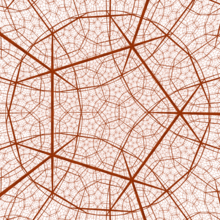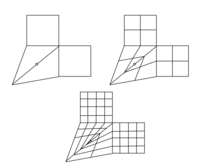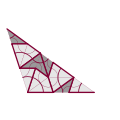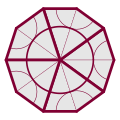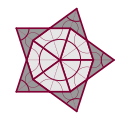33:
135:
1739:
1831:(in their example, a tree trunk) whose large-scale form oscillates wildly over time, even though the local subdivision laws remain the same. Cannon, Floyd and Parry also applied their model to the analysis of the growth patterns of rat tissue. They suggested that the "negatively curved" (or non-euclidean) nature of microscopic growth patterns of biological organisms is one of the key reasons why large-scale organisms do not look like crystals or polyhedral shapes but in fact in many cases resemble self-similar
4891:
1378:
119:
1721:
356:
394:
371:
383:
1827:(the kind used in 3D animated movies) and refines it to a mesh with more polygons by adding and shifting points according to different recursive formulas. Although many points get shifted in this process, each new mesh is combinatorially a subdivision of the old mesh (meaning that for every edge and vertex of the old mesh, you can identify a corresponding edge and vertex in the new one, plus several more edges and vertices).
427:
4903:
1506:
255:
309:
302:
295:
288:
243:
236:
229:
222:
210:
203:
196:
189:
276:
269:
262:
4927:
4915:
1757:
1830:
Subdivision rules were applied by Cannon, Floyd and Parry (2000) to the study of large-scale growth patterns of biological organisms. Cannon, Floyd and Parry produced a mathematical growth model which demonstrated that some systems determined by simple finite subdivision rules can results in objects
69:. Instead of repeating exactly the same design over and over, they have slight variations in each stage, allowing a richer structure while maintaining the elegant style of fractals. Subdivision rules have been used in architecture, biology, and computer science, as well as in the study of
3313:
if and only if it is Gromov hyperbolic, it has a sphere at infinity, and the natural subdivision rule on the sphere gives rise to a sequence of tilings that is conformal in the sense above. Thus, Cannon's conjecture would be true if all such subdivision rules were conformal.
4266:
378:
In each case, the subdivision rule would act on some tiling of a sphere (i.e. the night sky), but it is easier to just draw a small part of the night sky, corresponding to a single tile being repeatedly subdivided. This is what happens for the trefoil knot:
1898:
Subdivision rules give a sequence of tilings of a surface, and tilings give an idea of distance, length, and area (by letting each tile have length and area 1). In the limit, the distances that come from these tilings may converge in some sense to an
1889:
Cannon and
Swenson showed that a hyperbolic group with a 2-sphere at infinity has an associated subdivision rule. If this subdivision rule is conformal in a certain sense, the group will be a 3-manifold group with the geometry of hyperbolic 3-space.
1886:, which states (in part) that any Gromov hyperbolic group that is a 3-manifold group must act geometrically on hyperbolic 3-space. However, it still remains to be shown that a Gromov hyperbolic group with a 2-sphere at infinity is a 3-manifold group.
153:
is an example of a subdivision rule with one edge type (that gets subdivided into two edges) and one tile type (a triangle that gets subdivided into 6 smaller triangles). Any triangulated surface is a barycentric subdivision complex.
393:
126:
Since the only tile type is a quadrilateral, binary subdivision can only subdivide tilings made up of quadrilaterals. This means that the only subdivision complexes are tilings by quadrilaterals. The tiling can be
2546:
2453:
1369:
382:
332:
has a subdivision rule, with some tiles that do not subdivide, corresponding to the boundary of the link complement. The subdivision rules show what the night sky would look like to someone living in a
134:
1495:
1240:
864:
704:
46:. Note the recursive structure: each pentagon contains smaller pentagons, which contain smaller pentagons. This is an example of a subdivision rule arising from a finite universe (i.e. a
1130:
2934:
1024:
3073:
2598:
2744:
2695:
3311:
2028:
1986:
100:. Each tile type is represented by a label (usually a letter). Every tile type subdivides into smaller tile types. Each edge also gets subdivided according to finitely many
733:
548:
1835:. In particular they suggested that such "negatively curved" local structure is manifested in highly folded and highly connected nature of the brain and the lung tissue.
3686:
1685:
658:
918:
2300:
2228:
2136:
1643:
1607:
1296:
772:
3214:
3122:
3169:
2340:
2268:
2176:
2060:
1434:
1410:
799:
575:
519:
488:
1159:
1073:
4351:
430:
A subdivision rule for the four-torus. The faces of the B tiles that subdivide can only touch C tiles, and the faces of the B tiles that don't only touch A tiles.
3282:
3189:
3142:
3093:
3018:
2998:
2978:
2958:
2902:
2882:
2862:
2842:
2822:
2764:
2646:
2620:
2360:
2320:
2248:
2196:
2156:
2104:
2084:
1944:
1924:
1559:
1539:
1260:
1179:
1044:
985:
965:
945:
891:
635:
615:
595:
455:
3254:
2799:
3577:
3518:
161:
can be generated by a subdivision rule on a set of four tile types (the curved lines in the table below only help to show how the tiles fit together):
108:
for the subdivision rule. Given any subdivision complex for a subdivision rule, we can subdivide it over and over again to get a sequence of tilings.
4284:
37:
1690:
The quasi-isometry properties of the history graph can be studied using subdivision rules. For instance, the history graph is quasi-isometric to
1745:
3469:
1699:
3705:. This page contains most of the research papers by Cannon, Floyd and Parry on subdivision rules, as well as a gallery of subdivision rules.
4714:
2461:
2368:
4931:
1819:
in computer graphics use subdivision rules to refine a surface to any given level of precision. These subdivision surfaces (such as the
1436:
is the doubling map on the torus, wrapping the meridian around itself twice and the longitude around itself twice. This is a four-fold
4859:
4344:
3730:
65:
or other two-dimensional shape into smaller and smaller pieces. Subdivision rules in a sense are generalizations of regular geometric
3763:
1497:
given by the standard covering map. Under subdivision, each square in the plane gets subdivided into squares of one-fourth the size.
3702:
3461:
1820:
1301:
1377:
104:. Finite subdivision rules can only subdivide tilings that are made up of polygons labelled by tile types. Such tilings are called
118:
4395:
341:), an observer would see the visible universe repeat itself in an infinite pattern. The subdivision rule describes that pattern.
3450:
4809:
3380:
370:
3602:
1878:
Here, a geometric action is a cocompact, properly discontinuous action by isometries. This conjecture was partially solved by
4907:
4290:
1443:
1184:
1385:
The subdivision complex can be created by gluing together the opposite edges of the square, making the subdivision complex
355:
4337:
4146:
4103:
3658:
Perelman, Grisha (17 July 2003). "Finite extinction time for the solutions to the Ricci flow on certain three-manifolds".
1847:
807:
4224:
1562:
1903:
on the surface. The
Combinatorial Riemann Mapping Theorem gives necessary and sufficient conditions for this to occur.
4834:
4390:
4306:
3790:
3352:
3337:
142:
Here we start with a complex made of four quadrilaterals and subdivide it twice. All quadrilaterals are type A tiles.
32:
4405:
1861:
1777:
tiles in
Islamic architecture are self-similar tilings that can be modeled with finite subdivision rules. In 2007,
663:
96:
if there are only finitely many ways that every polygon can subdivide. Each way of subdividing a tile is called a
4819:
4791:
4428:
3956:
3584:
1883:
1078:
4864:
3812:
3616:
Perelman, Grisha (11 November 2002). "The entropy formula for the Ricci flow and its geometric applications".
415:
3567:
4749:
4739:
4709:
4643:
4378:
4249:
407:
150:
4919:
2907:
4847:
4744:
4724:
4719:
4648:
4373:
4298:
3857:
3723:
1868:
1440:. The plane, tiled by squares, is a subdivision complex for this subdivision rule, with the structure map
990:
3032:
2557:
4874:
4804:
4681:
4605:
4544:
4529:
4524:
4501:
4383:
4083:
3775:
2700:
2651:
2270:
is the infimum of the length of all possible paths circling the ring (i.e. not nullhomotopic in R). The
1738:
42:
4890:
3287:
4854:
4734:
4729:
4653:
4554:
4244:
4239:
4029:
3961:
3535:
1790:
86:
1991:
1949:
4869:
4779:
4701:
4600:
4534:
4491:
4481:
4461:
4002:
3979:
3914:
3862:
3847:
3780:
3096:
1816:
138:
We start with a complex with four quadrilaterals and subdivide twice. All squares are type A tiles.
74:
70:
1851:
709:
524:
410:
is used in all dimensions. Also, binary subdivision can be generalized to other dimensions (where
344:
The subdivision rule looks different for different geometries. This is a subdivision rule for the
4895:
4814:
4754:
4686:
4676:
4615:
4590:
4466:
4423:
4418:
4229:
4209:
4173:
4168:
3931:
3659:
3638:
3617:
3559:
3421:
3403:
2106:
can be given a length, defined to be the sum of the weights of all tiles in the path. Define the
1782:
1813:(presentation 1974, predecessor works starting in about 1964) predating them by five centuries.
1648:
640:
896:
4958:
4953:
4610:
4595:
4539:
4486:
4272:
4234:
4158:
4066:
3971:
3877:
3852:
3842:
3785:
3768:
3758:
3753:
3716:
3551:
3526:
3465:
3457:
2276:
2204:
2112:
1795:
1612:
1576:
1265:
741:
4824:
4799:
4671:
4519:
4456:
4189:
4056:
4039:
3867:
3543:
3501:
3456:
Pattern
Formation in Biology, Vision and Dynamics, pp. 65–82. World Scientific, 2000.
3413:
1879:
1872:
1864:
1806:
1720:
1691:
338:
318:
3147:
2325:
2253:
2161:
2045:
1419:
1388:
777:
553:
497:
466:
4764:
4691:
4620:
4413:
4204:
4141:
3802:
2035:
2031:
1900:
1843:
1786:
1135:
1049:
364:
349:
334:
329:
47:
3899:
3539:
3194:
3102:
1854:
first studied finite subdivision rules as an attempt to prove the following conjecture:
17:
4842:
4769:
4476:
4219:
4163:
4151:
4122:
4078:
4061:
4044:
3997:
3941:
3926:
3894:
3832:
3267:
3174:
3127:
3078:
3003:
2983:
2963:
2943:
2887:
2867:
2847:
2827:
2807:
2749:
2631:
2605:
2345:
2305:
2233:
2181:
2178:
to be the infimum of the length of all possible paths connecting the inner boundary of
2141:
2089:
2069:
1929:
1909:
1810:
1544:
1524:
1518:
1245:
1164:
1029:
970:
950:
930:
876:
620:
600:
580:
440:
158:
128:
3219:
2769:
4947:
4630:
4562:
4514:
4073:
4049:
3919:
3889:
3872:
3837:
3822:
3425:
322:
3563:
426:
4572:
4567:
4471:
4318:
4313:
4214:
4194:
3951:
3884:
1824:
1800:
1437:
345:
1505:
987:
which is the union of its closed 2-cells, together with a continuous cellular map
4774:
4438:
4361:
4279:
4199:
3909:
3904:
3637:
Perelman, Grisha (10 March 2003). "Ricci flow with surgery on three-manifolds".
406:
Subdivision rules can easily be generalized to other dimensions. For instance,
254:
4759:
4638:
4433:
4132:
4117:
4112:
4093:
3827:
3417:
1570:
1510:
461:
50:
3394:
Rushton, B. (2012). "A finite subdivision rule for the n-dimensional torus".
870:, whose restriction to every open cell is a homeomorphism onto an open cell.
4088:
4034:
3946:
3797:
3606:. Institute of Mathematical Sciences (Singapore) Lecture Notes Series. 2006.
3547:
411:
308:
301:
294:
287:
242:
235:
228:
221:
209:
202:
195:
188:
3555:
1569:
that records the action of the subdivision rule. The graph consists of the
397:
Subdivisions of the subdivision complex for the
Borromean rings complement.
275:
268:
261:
4329:
3519:"Decagonal and Quasi-crystalline Tilings in Medieval Islamic Architecture"
521:
is the union of its closed 2-cells. We assume that for each closed 2-cell
4663:
4582:
4509:
3989:
1778:
1026:
whose restriction to each open cell is a homeomorphism. We can subdivide
66:
3664:
3643:
3622:
4448:
4019:
3936:
3739:
3495:
1832:
1803:
1763:
62:
1376:
133:
117:
89:
of the plane by polygons and turns it into a new tiling by subdividing
4007:
3356:. Conformal Geometry and Dynamics, vol. 11 (2007), pp. 128–136.
2541:{\displaystyle m_{\inf }(R,T)=\inf {\frac {A(\rho )}{C(\rho )^{2}}}.}
2448:{\displaystyle M_{\sup }(R,T)=\sup {\frac {H(\rho )^{2}}{A(\rho )}},}
3369:. Conformal Geometry and Dynamics, vol. 14 (2010, pp. 113–140.
3341:. Conformal Geometry and Dynamics, vol. 5 (2001), pp. 153–196.
1799:
suggesting that girih tilings possessed properties consistent with
1756:
386:
Subdivisions of the subdivision complex for the trefoil complement.
3408:
1774:
1727:
1726:
An example of a subdivision rule used in the
Islamic art known as
1504:
1413:
425:
31:
1242:. By repeating this process, we obtain a sequence of subdivided
4333:
3712:
3264:
1364:{\displaystyle \phi _{R}^{n}\circ f:R^{n}(X)\rightarrow S_{R}}
3683:
Recognizing constant curvature discrete groups in dimension 3
392:
381:
369:
354:
3708:
3144:
in which the classical moduli and approximate moduli (from
893:
in the definition above (with its given characteristic map
2551:
Note that they are invariant under scaling of the metric.
2342:
is defined to be the sum of the squares of all weights in
321:
give rise to finite subdivision rules. This includes most
2766:
sufficiently large, lie in a single interval of the form
3216:-comparable, meaning that they lie in a single interval
337:; because the universe wraps around itself (i.e. is not
3603:
Subdivisions on arbitrary meshes: algorithms and theory
1521:
properties of certain spaces. Given a subdivision rule
414:
get divided by every midplane), as in the proof of the
1490:{\displaystyle f:\mathbb {R} ^{2}\rightarrow R(S_{R})}
1235:{\displaystyle \phi _{R}\circ f:R(X)\rightarrow S_{R}}
3381:
Constructing subdivision rules from alternating links
3290:
3270:
3222:
3197:
3177:
3150:
3130:
3105:
3081:
3035:
3006:
2986:
2966:
2946:
2910:
2890:
2870:
2850:
2830:
2810:
2772:
2752:
2703:
2654:
2634:
2608:
2560:
2464:
2371:
2348:
2328:
2308:
2279:
2256:
2236:
2207:
2184:
2164:
2144:
2115:
2092:
2072:
2048:
1994:
1952:
1932:
1912:
1651:
1615:
1579:
1547:
1527:
1446:
1422:
1391:
1304:
1268:
1248:
1187:
1167:
1138:
1081:
1052:
1032:
993:
973:
953:
933:
899:
879:
810:
780:
744:
712:
666:
643:
623:
617:
has at least two vertices, the vertices and edges of
603:
583:
556:
527:
500:
469:
443:
4833:
4790:
4700:
4662:
4629:
4581:
4553:
4500:
4447:
4404:
4258:
4182:
4131:
4102:
4018:
3988:
3970:
3811:
3746:
3452:
Crystal growth, biological cell growth and geometry
859:{\displaystyle \phi _{R}:R(S_{R})\rightarrow S_{R}}
3305:
3276:
3248:
3208:
3183:
3163:
3136:
3116:
3087:
3067:
3012:
2992:
2972:
2952:
2928:
2896:
2876:
2856:
2836:
2816:
2793:
2758:
2738:
2689:
2640:
2614:
2592:
2540:
2447:
2354:
2334:
2314:
2294:
2262:
2242:
2222:
2190:
2170:
2150:
2130:
2098:
2078:
2054:
2022:
1980:
1938:
1918:
1679:
1637:
1601:
1553:
1533:
1489:
1428:
1404:
1363:
1290:
1254:
1234:
1173:
1153:
1132:restricts to a homeomorphism onto each open cell.
1124:
1067:
1038:
1018:
979:
959:
939:
912:
885:
858:
793:
766:
735:restricts to a homeomorphism onto each open cell.
727:
698:
652:
629:
609:
589:
569:
542:
513:
482:
449:
3687:Transactions of the American Mathematical Society
3353:Constructing subdivision rules from rational maps
2709:
2660:
2493:
2470:
2400:
2377:
2000:
1958:
1946:(i.e., a closed annulus) gives two invariants,
1906:Its statement needs some background. A tiling
1609:, together with edges connecting each tile in
4345:
3724:
3191:sufficiently large) of any given annulus are
77:are a well-studied type of subdivision rule.
8:
3384:. Conform. Geom. Dyn. 14 (2010), 1–13.
2923:
2917:
1766:may be modelled by finite subdivision rules.
699:{\displaystyle \psi _{s}:s\rightarrow S_{R}}
1517:Subdivision rules can be used to study the
4352:
4338:
4330:
3731:
3717:
3709:
3517:Lu, Peter J.; Steinhardt, Paul J. (2007).
1125:{\displaystyle f:R(X)\rightarrow R(S_{R})}
92:each polygon into smaller polygons. It is
3663:
3642:
3621:
3497:The combinatorial Riemann mapping theorem
3407:
3297:
3293:
3292:
3289:
3269:
3221:
3196:
3176:
3155:
3149:
3129:
3104:
3080:
3053:
3040:
3034:
3005:
2985:
2965:
2945:
2909:
2889:
2869:
2849:
2829:
2809:
2771:
2751:
2727:
2708:
2702:
2678:
2659:
2653:
2633:
2607:
2578:
2565:
2559:
2526:
2496:
2469:
2463:
2419:
2403:
2376:
2370:
2347:
2327:
2307:
2278:
2255:
2235:
2206:
2183:
2163:
2143:
2114:
2091:
2071:
2047:
1999:
1993:
1957:
1951:
1931:
1911:
1748:of a cube with subdivision surface below.
1656:
1650:
1620:
1614:
1584:
1578:
1546:
1526:
1478:
1459:
1455:
1454:
1445:
1421:
1396:
1390:
1355:
1333:
1314:
1309:
1303:
1273:
1267:
1247:
1226:
1192:
1186:
1166:
1137:
1113:
1080:
1051:
1031:
1010:
992:
972:
952:
932:
904:
898:
878:
850:
834:
815:
809:
785:
779:
755:
743:
714:
713:
711:
690:
671:
665:
642:
622:
602:
582:
561:
555:
529:
528:
526:
505:
499:
474:
468:
442:
363:And this is the subdivision rule for the
3365:J. W. Cannon, W. J. Floyd, W. R. Parry.
3350:J. W. Cannon, W. J. Floyd, W. R. Parry.
3335:J. W. Cannon, W. J. Floyd, W. R. Parry.
3331:
3329:
3327:
494:, with a fixed cell structure such that
163:
27:Way to divide polygon into smaller parts
4285:List of fractals by Hausdorff dimension
3512:
3510:
3323:
2062:assigns a non-negative number called a
738:2. A finite two dimensional CW complex
3445:
3443:
3441:
3439:
3437:
3435:
3095:) in the above sense, then there is a
3075:of tilings of a surface is conformal (
402:Subdivision rules in higher dimensions
3689:350 (1998), no. 2, pp. 809–849.
3677:
3675:
3504:173 (1994), no. 2, pp. 155–234.
3449:J. W. Cannon, W. Floyd and W. Parry.
2929:{\displaystyle N\smallsetminus \{x\}}
2034:. These are similar to the classical
1894:Combinatorial Riemann mapping theorem
1700:combinatorial Riemann mapping theorem
1694:exactly when the subdivision rule is
115:has one tile type and one edge type:
7:
4914:
3490:
3488:
3486:
3484:
3482:
3480:
3478:
1019:{\displaystyle f:X\rightarrow S_{R}}
146:Examples of finite subdivision rules
4926:
3068:{\displaystyle T_{1},T_{2},\ldots }
2593:{\displaystyle T_{1},T_{2},\ldots }
1374:Binary subdivision is one example:
328:Every prime, non-split alternating
2739:{\displaystyle m_{\inf }(R,T_{i})}
2690:{\displaystyle M_{\sup }(R,T_{i})}
1713:Applications of subdivision rules.
1075:by requiring that the induced map
644:
25:
4267:How Long Is the Coast of Britain?
3367:Lattès maps and subdivision rules
2038:. They are defined by the use of
1821:Catmull-Clark subdivision surface
1793:published a paper in the journal
61:is a recursive way of dividing a
4925:
4913:
4902:
4901:
4889:
3681:J. W. Cannon and E. L. Swenson,
3306:{\displaystyle \mathbb {H} ^{3}}
1755:
1737:
1719:
947:-complex for a subdivision rule
307:
300:
293:
286:
274:
267:
260:
253:
241:
234:
227:
220:
208:
201:
194:
187:
4810:Computational complexity theory
2824:in the surface, a neighborhood
390:And for the Borromean rings:
4291:The Fractal Geometry of Nature
3243:
3223:
3099:on the surface and a constant
2788:
2773:
2733:
2714:
2684:
2665:
2523:
2516:
2508:
2502:
2487:
2475:
2436:
2430:
2416:
2409:
2394:
2382:
2289:
2283:
2217:
2211:
2125:
2119:
2023:{\displaystyle m_{\inf }(R,T)}
2017:
2005:
1981:{\displaystyle M_{\sup }(R,T)}
1975:
1963:
1674:
1668:
1632:
1626:
1596:
1590:
1484:
1471:
1465:
1348:
1345:
1339:
1285:
1279:
1219:
1216:
1210:
1148:
1142:
1119:
1106:
1100:
1097:
1091:
1062:
1056:
1003:
967:is a 2-dimensional CW complex
843:
840:
827:
761:
748:
719:
683:
534:
36:A perspective projection of a
1:
660:, and the characteristic map
597:on a closed 2-disk such that
3578:"Supporting Online Material"
1867:with a 2-sphere at infinity
1381:The binary subdivision rule.
804:3.A continuous cellular map
774:, which is a subdivision of
728:{\displaystyle {\tilde {s}}}
543:{\displaystyle {\tilde {s}}}
4307:Chaos: Making a New Science
2198:to the outer boundary. The
457:consists of the following.
122:The binary subdivision rule
85:A subdivision rule takes a
4975:
4860:Films about mathematicians
3703:Bill Floyd's research page
2980:the approximate moduli of
2960:, such that for all large
2624:if mesh approaches 0 and:
1838:
1680:{\displaystyle R^{n+1}(X)}
653:{\displaystyle \partial s}
460:1. A finite 2-dimensional
374:Borromean subdivision rule
131:, but doesn't have to be:
4883:
4429:Philosophy of mathematics
4369:
3418:10.1007/s10711-012-9802-5
2648:, the approximate moduli
1884:geometrization conjecture
1746:Catmull-Clark subdivision
1645:with its subdivisions in
1509:The history graph of the
1501:Quasi-isometry properties
913:{\displaystyle \psi _{s}}
38:dodecahedral tessellation
4865:Recreational mathematics
3338:Finite subdivision rules
2295:{\displaystyle A(\rho )}
2223:{\displaystyle C(\rho )}
2131:{\displaystyle H(\rho )}
1762:The branching nature of
1638:{\displaystyle R^{n}(X)}
1602:{\displaystyle R^{n}(X)}
1541:and subdivision complex
1291:{\displaystyle R^{n}(X)}
767:{\displaystyle R(S_{R})}
577:there is a CW structure
359:Trefoil subdivision rule
18:Cannon's conjecture
4750:Mathematical statistics
4740:Mathematical psychology
4710:Engineering mathematics
4644:Algebraic number theory
3548:10.1126/science.1135491
2940:from the complement of
436:finite subdivision rule
408:barycentric subdivision
367:, which is hyperbolic:
330:knot or link complement
151:Barycentric subdivision
59:finite subdivision rule
4896:Mathematics portal
4745:Mathematical sociology
4725:Mathematical economics
4720:Mathematical chemistry
4649:Analytic number theory
4530:Differential equations
4299:The Beauty of Fractals
3307:
3284:acts geometrically on
3278:
3250:
3210:
3185:
3165:
3138:
3118:
3089:
3069:
3014:
2994:
2974:
2954:
2930:
2898:
2878:
2858:
2838:
2818:
2795:
2760:
2740:
2691:
2642:
2616:
2594:
2542:
2449:
2356:
2336:
2316:
2296:
2264:
2244:
2224:
2192:
2172:
2152:
2132:
2100:
2080:
2056:
2024:
1982:
1940:
1920:
1698:, as described in the
1681:
1639:
1603:
1555:
1535:
1514:
1491:
1430:
1416:. The subdivision map
1406:
1382:
1365:
1292:
1256:
1236:
1175:
1155:
1126:
1069:
1040:
1020:
981:
961:
941:
914:
887:
860:
795:
768:
729:
700:
654:
631:
611:
591:
571:
544:
515:
484:
451:
431:
398:
387:
375:
360:
139:
123:
54:
4875:Mathematics education
4805:Theory of computation
4525:Hypercomplex analysis
3308:
3279:
3251:
3211:
3186:
3166:
3164:{\displaystyle T_{i}}
3139:
3119:
3090:
3070:
3015:
3000:are all greater than
2995:
2975:
2955:
2931:
2899:
2879:
2859:
2839:
2819:
2796:
2761:
2741:
2692:
2643:
2617:
2595:
2543:
2450:
2357:
2337:
2335:{\displaystyle \rho }
2317:
2297:
2265:
2263:{\displaystyle \rho }
2245:
2225:
2193:
2173:
2171:{\displaystyle \rho }
2153:
2133:
2101:
2081:
2057:
2055:{\displaystyle \rho }
2025:
1983:
1941:
1921:
1744:First three steps of
1682:
1640:
1604:
1561:, we can construct a
1556:
1536:
1508:
1492:
1431:
1429:{\displaystyle \phi }
1407:
1405:{\displaystyle S_{R}}
1380:
1366:
1293:
1257:
1237:
1176:
1156:
1127:
1070:
1041:
1021:
982:
962:
942:
915:
888:
861:
796:
794:{\displaystyle S_{R}}
769:
730:
701:
655:
632:
612:
592:
572:
570:{\displaystyle S_{R}}
545:
516:
514:{\displaystyle S_{R}}
485:
483:{\displaystyle S_{R}}
452:
429:
396:
385:
373:
358:
137:
121:
106:subdivision complexes
35:
4855:Informal mathematics
4735:Mathematical physics
4730:Mathematical finance
4715:Mathematical biology
4654:Diophantine geometry
4245:Lewis Fry Richardson
4240:Hamid Naderi Yeganeh
4030:Burning Ship fractal
3962:Weierstrass function
3288:
3268:
3220:
3195:
3175:
3148:
3128:
3103:
3079:
3033:
3025:Statement of theorem
3004:
2984:
2964:
2944:
2908:
2888:
2868:
2848:
2828:
2808:
2770:
2750:
2701:
2652:
2632:
2606:
2558:
2462:
2369:
2346:
2326:
2306:
2277:
2254:
2234:
2205:
2182:
2162:
2142:
2113:
2090:
2070:
2046:
2042:. A weight function
1992:
1950:
1930:
1910:
1882:in his proof of the
1817:Subdivision surfaces
1791:Princeton University
1649:
1613:
1577:
1545:
1525:
1444:
1420:
1389:
1302:
1266:
1246:
1185:
1165:
1154:{\displaystyle R(X)}
1136:
1079:
1068:{\displaystyle R(X)}
1050:
1030:
991:
971:
951:
931:
897:
877:
808:
778:
742:
710:
664:
641:
621:
601:
581:
554:
525:
498:
467:
441:
75:Substitution tilings
71:hyperbolic manifolds
4870:Mathematics and art
4780:Operations research
4535:Functional analysis
4003:Space-filling curve
3980:Multifractal system
3863:Space-filling curve
3848:Sierpinski triangle
3540:2007Sci...315.1106L
3534:(5815): 1106–1110.
3396:Geometriae Dedicata
3097:conformal structure
1858:Cannon's conjecture
1839:Cannon's conjecture
1319:
492:subdivision complex
422:Rigorous definition
416:Heine–Borel theorem
4815:Numerical analysis
4424:Mathematical logic
4419:Information theory
4230:Aleksandr Lyapunov
4210:Desmond Paul Henry
4174:Self-avoiding walk
4169:Percolation theory
3813:Iterated function
3754:Fractal dimensions
3303:
3274:
3246:
3209:{\displaystyle K'}
3206:
3181:
3161:
3134:
3124:depending only on
3117:{\displaystyle K'}
3114:
3085:
3065:
3010:
2990:
2970:
2950:
2926:
2894:
2884:, there is a ring
2874:
2854:
2834:
2814:
2791:
2756:
2736:
2687:
2638:
2612:
2590:
2538:
2445:
2352:
2332:
2312:
2292:
2260:
2240:
2220:
2188:
2168:
2148:
2128:
2096:
2076:
2052:
2032:approximate moduli
2020:
1978:
1936:
1916:
1901:analytic structure
1873:hyperbolic 3-space
1869:acts geometrically
1787:Paul J. Steinhardt
1783:Harvard University
1677:
1635:
1599:
1551:
1531:
1515:
1487:
1426:
1402:
1383:
1361:
1305:
1288:
1252:
1232:
1181:-complex with map
1171:
1151:
1122:
1065:
1036:
1016:
977:
957:
937:
910:
883:
856:
791:
764:
725:
696:
650:
627:
607:
587:
567:
540:
511:
480:
447:
432:
399:
388:
376:
361:
140:
124:
113:binary subdivision
57:In mathematics, a
55:
4941:
4940:
4540:Harmonic analysis
4327:
4326:
4273:Coastline paradox
4250:Wacław Sierpiński
4235:Benoit Mandelbrot
4159:Fractal landscape
4067:Misiurewicz point
3972:Strange attractor
3853:Apollonian gasket
3843:Sierpinski carpet
3494:James W. Cannon.
3470:978-981-02-3792-9
3277:{\displaystyle G}
3184:{\displaystyle i}
3137:{\displaystyle K}
3088:{\displaystyle K}
3013:{\displaystyle I}
2993:{\displaystyle R}
2973:{\displaystyle i}
2953:{\displaystyle N}
2897:{\displaystyle R}
2877:{\displaystyle I}
2864:, and an integer
2857:{\displaystyle x}
2837:{\displaystyle N}
2817:{\displaystyle x}
2759:{\displaystyle i}
2641:{\displaystyle R}
2615:{\displaystyle K}
2533:
2440:
2355:{\displaystyle R}
2315:{\displaystyle R}
2243:{\displaystyle R}
2191:{\displaystyle R}
2151:{\displaystyle R}
2099:{\displaystyle R}
2079:{\displaystyle T}
2036:modulus of a ring
1939:{\displaystyle R}
1919:{\displaystyle T}
1554:{\displaystyle X}
1534:{\displaystyle R}
1513:subdivision rule.
1255:{\displaystyle R}
1174:{\displaystyle R}
1039:{\displaystyle X}
980:{\displaystyle X}
960:{\displaystyle R}
940:{\displaystyle R}
886:{\displaystyle s}
722:
637:are contained in
630:{\displaystyle s}
610:{\displaystyle s}
590:{\displaystyle s}
537:
450:{\displaystyle R}
348:, which is not a
315:
314:
16:(Redirected from
4966:
4929:
4928:
4917:
4916:
4905:
4904:
4894:
4893:
4825:Computer algebra
4800:Computer science
4520:Complex analysis
4354:
4347:
4340:
4331:
4190:Michael Barnsley
4057:Lyapunov fractal
3915:Sierpiński curve
3868:Blancmange curve
3733:
3726:
3719:
3710:
3690:
3679:
3670:
3669:
3667:
3655:
3649:
3648:
3646:
3634:
3628:
3627:
3625:
3613:
3607:
3598:
3592:
3591:
3589:
3583:. Archived from
3582:
3574:
3572:
3566:. Archived from
3523:
3514:
3505:
3502:Acta Mathematica
3492:
3473:
3447:
3430:
3429:
3411:
3391:
3385:
3376:
3370:
3363:
3357:
3348:
3342:
3333:
3312:
3310:
3309:
3304:
3302:
3301:
3296:
3283:
3281:
3280:
3275:
3255:
3253:
3252:
3249:{\displaystyle }
3247:
3239:
3215:
3213:
3212:
3207:
3205:
3190:
3188:
3187:
3182:
3170:
3168:
3167:
3162:
3160:
3159:
3143:
3141:
3140:
3135:
3123:
3121:
3120:
3115:
3113:
3094:
3092:
3091:
3086:
3074:
3072:
3071:
3066:
3058:
3057:
3045:
3044:
3019:
3017:
3016:
3011:
2999:
2997:
2996:
2991:
2979:
2977:
2976:
2971:
2959:
2957:
2956:
2951:
2935:
2933:
2932:
2927:
2903:
2901:
2900:
2895:
2883:
2881:
2880:
2875:
2863:
2861:
2860:
2855:
2843:
2841:
2840:
2835:
2823:
2821:
2820:
2815:
2800:
2798:
2797:
2794:{\displaystyle }
2792:
2765:
2763:
2762:
2757:
2745:
2743:
2742:
2737:
2732:
2731:
2713:
2712:
2696:
2694:
2693:
2688:
2683:
2682:
2664:
2663:
2647:
2645:
2644:
2639:
2621:
2619:
2618:
2613:
2599:
2597:
2596:
2591:
2583:
2582:
2570:
2569:
2547:
2545:
2544:
2539:
2534:
2532:
2531:
2530:
2511:
2497:
2474:
2473:
2454:
2452:
2451:
2446:
2441:
2439:
2425:
2424:
2423:
2404:
2381:
2380:
2361:
2359:
2358:
2353:
2341:
2339:
2338:
2333:
2321:
2319:
2318:
2313:
2301:
2299:
2298:
2293:
2269:
2267:
2266:
2261:
2249:
2247:
2246:
2241:
2229:
2227:
2226:
2221:
2197:
2195:
2194:
2189:
2177:
2175:
2174:
2169:
2157:
2155:
2154:
2149:
2137:
2135:
2134:
2129:
2105:
2103:
2102:
2097:
2086:. Every path in
2085:
2083:
2082:
2077:
2066:to each tile of
2061:
2059:
2058:
2053:
2040:weight functions
2029:
2027:
2026:
2021:
2004:
2003:
1987:
1985:
1984:
1979:
1962:
1961:
1945:
1943:
1942:
1937:
1925:
1923:
1922:
1917:
1880:Grigori Perelman
1865:hyperbolic group
1809:tilings such as
1807:quasicrystalline
1759:
1741:
1723:
1692:hyperbolic space
1686:
1684:
1683:
1678:
1667:
1666:
1644:
1642:
1641:
1636:
1625:
1624:
1608:
1606:
1605:
1600:
1589:
1588:
1560:
1558:
1557:
1552:
1540:
1538:
1537:
1532:
1496:
1494:
1493:
1488:
1483:
1482:
1464:
1463:
1458:
1435:
1433:
1432:
1427:
1411:
1409:
1408:
1403:
1401:
1400:
1370:
1368:
1367:
1362:
1360:
1359:
1338:
1337:
1318:
1313:
1297:
1295:
1294:
1289:
1278:
1277:
1261:
1259:
1258:
1253:
1241:
1239:
1238:
1233:
1231:
1230:
1197:
1196:
1180:
1178:
1177:
1172:
1160:
1158:
1157:
1152:
1131:
1129:
1128:
1123:
1118:
1117:
1074:
1072:
1071:
1066:
1045:
1043:
1042:
1037:
1025:
1023:
1022:
1017:
1015:
1014:
986:
984:
983:
978:
966:
964:
963:
958:
946:
944:
943:
938:
919:
917:
916:
911:
909:
908:
892:
890:
889:
884:
873:Each CW complex
865:
863:
862:
857:
855:
854:
839:
838:
820:
819:
800:
798:
797:
792:
790:
789:
773:
771:
770:
765:
760:
759:
734:
732:
731:
726:
724:
723:
715:
706:which maps onto
705:
703:
702:
697:
695:
694:
676:
675:
659:
657:
656:
651:
636:
634:
633:
628:
616:
614:
613:
608:
596:
594:
593:
588:
576:
574:
573:
568:
566:
565:
549:
547:
546:
541:
539:
538:
530:
520:
518:
517:
512:
510:
509:
489:
487:
486:
481:
479:
478:
456:
454:
453:
448:
339:simply connected
311:
304:
297:
290:
278:
271:
264:
257:
245:
238:
231:
224:
212:
205:
198:
191:
164:
21:
4974:
4973:
4969:
4968:
4967:
4965:
4964:
4963:
4944:
4943:
4942:
4937:
4888:
4879:
4829:
4786:
4765:Systems science
4696:
4692:Homotopy theory
4658:
4625:
4577:
4549:
4496:
4443:
4414:Category theory
4400:
4365:
4358:
4328:
4323:
4254:
4205:Felix Hausdorff
4178:
4142:Brownian motion
4127:
4098:
4021:
4014:
3984:
3966:
3957:Pythagoras tree
3814:
3807:
3803:Self-similarity
3747:Characteristics
3742:
3737:
3699:
3694:
3693:
3680:
3673:
3665:math.DG/0307245
3657:
3656:
3652:
3644:math.DG/0303109
3636:
3635:
3631:
3623:math.DG/0211159
3615:
3614:
3610:
3599:
3595:
3587:
3580:
3576:
3575:
3570:
3521:
3516:
3515:
3508:
3493:
3476:
3448:
3433:
3393:
3392:
3388:
3377:
3373:
3364:
3360:
3349:
3345:
3334:
3325:
3320:
3291:
3286:
3285:
3266:
3265:
3262:
3232:
3218:
3217:
3198:
3193:
3192:
3173:
3172:
3151:
3146:
3145:
3126:
3125:
3106:
3101:
3100:
3077:
3076:
3049:
3036:
3031:
3030:
3027:
3002:
3001:
2982:
2981:
2962:
2961:
2942:
2941:
2906:
2905:
2886:
2885:
2866:
2865:
2846:
2845:
2826:
2825:
2806:
2805:
2768:
2767:
2748:
2747:
2723:
2704:
2699:
2698:
2674:
2655:
2650:
2649:
2630:
2629:
2604:
2603:
2574:
2561:
2556:
2555:
2522:
2512:
2498:
2465:
2460:
2459:
2426:
2415:
2405:
2372:
2367:
2366:
2362:. Then define
2344:
2343:
2324:
2323:
2304:
2303:
2275:
2274:
2252:
2251:
2232:
2231:
2203:
2202:
2180:
2179:
2160:
2159:
2140:
2139:
2111:
2110:
2088:
2087:
2068:
2067:
2044:
2043:
1995:
1990:
1989:
1953:
1948:
1947:
1928:
1927:
1908:
1907:
1896:
1841:
1811:Penrose tilings
1771:
1770:
1769:
1768:
1767:
1760:
1751:
1750:
1749:
1742:
1733:
1732:
1731:
1724:
1715:
1714:
1708:
1652:
1647:
1646:
1616:
1611:
1610:
1580:
1575:
1574:
1573:of every stage
1543:
1542:
1523:
1522:
1503:
1474:
1453:
1442:
1441:
1418:
1417:
1392:
1387:
1386:
1351:
1329:
1300:
1299:
1269:
1264:
1263:
1244:
1243:
1222:
1188:
1183:
1182:
1163:
1162:
1134:
1133:
1109:
1077:
1076:
1048:
1047:
1046:into a complex
1028:
1027:
1006:
989:
988:
969:
968:
949:
948:
929:
928:
900:
895:
894:
875:
874:
868:subdivision map
846:
830:
811:
806:
805:
781:
776:
775:
751:
740:
739:
708:
707:
686:
667:
662:
661:
639:
638:
619:
618:
599:
598:
579:
578:
557:
552:
551:
523:
522:
501:
496:
495:
470:
465:
464:
439:
438:
424:
404:
365:Borromean rings
350:hyperbolic knot
335:knot complement
148:
83:
28:
23:
22:
15:
12:
11:
5:
4972:
4970:
4962:
4961:
4956:
4946:
4945:
4939:
4938:
4936:
4935:
4923:
4911:
4899:
4884:
4881:
4880:
4878:
4877:
4872:
4867:
4862:
4857:
4852:
4851:
4850:
4843:Mathematicians
4839:
4837:
4835:Related topics
4831:
4830:
4828:
4827:
4822:
4817:
4812:
4807:
4802:
4796:
4794:
4788:
4787:
4785:
4784:
4783:
4782:
4777:
4772:
4770:Control theory
4762:
4757:
4752:
4747:
4742:
4737:
4732:
4727:
4722:
4717:
4712:
4706:
4704:
4698:
4697:
4695:
4694:
4689:
4684:
4679:
4674:
4668:
4666:
4660:
4659:
4657:
4656:
4651:
4646:
4641:
4635:
4633:
4627:
4626:
4624:
4623:
4618:
4613:
4608:
4603:
4598:
4593:
4587:
4585:
4579:
4578:
4576:
4575:
4570:
4565:
4559:
4557:
4551:
4550:
4548:
4547:
4545:Measure theory
4542:
4537:
4532:
4527:
4522:
4517:
4512:
4506:
4504:
4498:
4497:
4495:
4494:
4489:
4484:
4479:
4474:
4469:
4464:
4459:
4453:
4451:
4445:
4444:
4442:
4441:
4436:
4431:
4426:
4421:
4416:
4410:
4408:
4402:
4401:
4399:
4398:
4393:
4388:
4387:
4386:
4381:
4370:
4367:
4366:
4359:
4357:
4356:
4349:
4342:
4334:
4325:
4324:
4322:
4321:
4316:
4311:
4303:
4295:
4287:
4282:
4277:
4276:
4275:
4262:
4260:
4256:
4255:
4253:
4252:
4247:
4242:
4237:
4232:
4227:
4222:
4220:Helge von Koch
4217:
4212:
4207:
4202:
4197:
4192:
4186:
4184:
4180:
4179:
4177:
4176:
4171:
4166:
4161:
4156:
4155:
4154:
4152:Brownian motor
4149:
4138:
4136:
4129:
4128:
4126:
4125:
4123:Pickover stalk
4120:
4115:
4109:
4107:
4100:
4099:
4097:
4096:
4091:
4086:
4081:
4079:Newton fractal
4076:
4071:
4070:
4069:
4062:Mandelbrot set
4059:
4054:
4053:
4052:
4047:
4045:Newton fractal
4042:
4032:
4026:
4024:
4016:
4015:
4013:
4012:
4011:
4010:
4000:
3998:Fractal canopy
3994:
3992:
3986:
3985:
3983:
3982:
3976:
3974:
3968:
3967:
3965:
3964:
3959:
3954:
3949:
3944:
3942:Vicsek fractal
3939:
3934:
3929:
3924:
3923:
3922:
3917:
3912:
3907:
3902:
3897:
3892:
3887:
3882:
3881:
3880:
3870:
3860:
3858:Fibonacci word
3855:
3850:
3845:
3840:
3835:
3833:Koch snowflake
3830:
3825:
3819:
3817:
3809:
3808:
3806:
3805:
3800:
3795:
3794:
3793:
3788:
3783:
3778:
3773:
3772:
3771:
3761:
3750:
3748:
3744:
3743:
3738:
3736:
3735:
3728:
3721:
3713:
3707:
3706:
3698:
3697:External links
3695:
3692:
3691:
3671:
3650:
3629:
3608:
3593:
3590:on 2009-03-26.
3573:on 2009-10-07.
3506:
3474:
3431:
3386:
3371:
3358:
3343:
3322:
3321:
3319:
3316:
3300:
3295:
3273:
3261:
3258:
3245:
3242:
3238:
3235:
3231:
3228:
3225:
3204:
3201:
3180:
3158:
3154:
3133:
3112:
3109:
3084:
3064:
3061:
3056:
3052:
3048:
3043:
3039:
3029:If a sequence
3026:
3023:
3022:
3021:
3009:
2989:
2969:
2949:
2925:
2922:
2919:
2916:
2913:
2893:
2873:
2853:
2833:
2813:
2804:Given a point
2802:
2790:
2787:
2784:
2781:
2778:
2775:
2755:
2735:
2730:
2726:
2722:
2719:
2716:
2711:
2707:
2686:
2681:
2677:
2673:
2670:
2667:
2662:
2658:
2637:
2628:For each ring
2611:
2600:of tilings is
2589:
2586:
2581:
2577:
2573:
2568:
2564:
2549:
2548:
2537:
2529:
2525:
2521:
2518:
2515:
2510:
2507:
2504:
2501:
2495:
2492:
2489:
2486:
2483:
2480:
2477:
2472:
2468:
2456:
2455:
2444:
2438:
2435:
2432:
2429:
2422:
2418:
2414:
2411:
2408:
2402:
2399:
2396:
2393:
2390:
2387:
2384:
2379:
2375:
2351:
2331:
2311:
2291:
2288:
2285:
2282:
2259:
2239:
2219:
2216:
2213:
2210:
2187:
2167:
2147:
2127:
2124:
2121:
2118:
2095:
2075:
2051:
2019:
2016:
2013:
2010:
2007:
2002:
1998:
1977:
1974:
1971:
1968:
1965:
1960:
1956:
1935:
1915:
1895:
1892:
1840:
1837:
1785:and Professor
1761:
1754:
1753:
1752:
1743:
1736:
1735:
1734:
1725:
1718:
1717:
1716:
1712:
1711:
1710:
1709:
1707:
1704:
1676:
1673:
1670:
1665:
1662:
1659:
1655:
1634:
1631:
1628:
1623:
1619:
1598:
1595:
1592:
1587:
1583:
1550:
1530:
1519:quasi-isometry
1502:
1499:
1486:
1481:
1477:
1473:
1470:
1467:
1462:
1457:
1452:
1449:
1425:
1399:
1395:
1358:
1354:
1350:
1347:
1344:
1341:
1336:
1332:
1328:
1325:
1322:
1317:
1312:
1308:
1287:
1284:
1281:
1276:
1272:
1251:
1229:
1225:
1221:
1218:
1215:
1212:
1209:
1206:
1203:
1200:
1195:
1191:
1170:
1150:
1147:
1144:
1141:
1121:
1116:
1112:
1108:
1105:
1102:
1099:
1096:
1093:
1090:
1087:
1084:
1064:
1061:
1058:
1055:
1035:
1013:
1009:
1005:
1002:
999:
996:
976:
956:
936:
920:) is called a
907:
903:
882:
853:
849:
845:
842:
837:
833:
829:
826:
823:
818:
814:
788:
784:
763:
758:
754:
750:
747:
721:
718:
693:
689:
685:
682:
679:
674:
670:
649:
646:
626:
606:
586:
564:
560:
536:
533:
508:
504:
477:
473:
446:
423:
420:
403:
400:
313:
312:
305:
298:
291:
284:
280:
279:
272:
265:
258:
251:
247:
246:
239:
232:
225:
218:
214:
213:
206:
199:
192:
185:
181:
180:
177:
174:
171:
170:Initial tiles
168:
159:Penrose tiling
147:
144:
111:For instance,
82:
79:
26:
24:
14:
13:
10:
9:
6:
4:
3:
2:
4971:
4960:
4957:
4955:
4952:
4951:
4949:
4934:
4933:
4924:
4922:
4921:
4912:
4910:
4909:
4900:
4898:
4897:
4892:
4886:
4885:
4882:
4876:
4873:
4871:
4868:
4866:
4863:
4861:
4858:
4856:
4853:
4849:
4846:
4845:
4844:
4841:
4840:
4838:
4836:
4832:
4826:
4823:
4821:
4818:
4816:
4813:
4811:
4808:
4806:
4803:
4801:
4798:
4797:
4795:
4793:
4792:Computational
4789:
4781:
4778:
4776:
4773:
4771:
4768:
4767:
4766:
4763:
4761:
4758:
4756:
4753:
4751:
4748:
4746:
4743:
4741:
4738:
4736:
4733:
4731:
4728:
4726:
4723:
4721:
4718:
4716:
4713:
4711:
4708:
4707:
4705:
4703:
4699:
4693:
4690:
4688:
4685:
4683:
4680:
4678:
4675:
4673:
4670:
4669:
4667:
4665:
4661:
4655:
4652:
4650:
4647:
4645:
4642:
4640:
4637:
4636:
4634:
4632:
4631:Number theory
4628:
4622:
4619:
4617:
4614:
4612:
4609:
4607:
4604:
4602:
4599:
4597:
4594:
4592:
4589:
4588:
4586:
4584:
4580:
4574:
4571:
4569:
4566:
4564:
4563:Combinatorics
4561:
4560:
4558:
4556:
4552:
4546:
4543:
4541:
4538:
4536:
4533:
4531:
4528:
4526:
4523:
4521:
4518:
4516:
4515:Real analysis
4513:
4511:
4508:
4507:
4505:
4503:
4499:
4493:
4490:
4488:
4485:
4483:
4480:
4478:
4475:
4473:
4470:
4468:
4465:
4463:
4460:
4458:
4455:
4454:
4452:
4450:
4446:
4440:
4437:
4435:
4432:
4430:
4427:
4425:
4422:
4420:
4417:
4415:
4412:
4411:
4409:
4407:
4403:
4397:
4394:
4392:
4389:
4385:
4382:
4380:
4377:
4376:
4375:
4372:
4371:
4368:
4363:
4355:
4350:
4348:
4343:
4341:
4336:
4335:
4332:
4320:
4317:
4315:
4312:
4309:
4308:
4304:
4301:
4300:
4296:
4293:
4292:
4288:
4286:
4283:
4281:
4278:
4274:
4271:
4270:
4268:
4264:
4263:
4261:
4257:
4251:
4248:
4246:
4243:
4241:
4238:
4236:
4233:
4231:
4228:
4226:
4223:
4221:
4218:
4216:
4213:
4211:
4208:
4206:
4203:
4201:
4198:
4196:
4193:
4191:
4188:
4187:
4185:
4181:
4175:
4172:
4170:
4167:
4165:
4162:
4160:
4157:
4153:
4150:
4148:
4147:Brownian tree
4145:
4144:
4143:
4140:
4139:
4137:
4134:
4130:
4124:
4121:
4119:
4116:
4114:
4111:
4110:
4108:
4105:
4101:
4095:
4092:
4090:
4087:
4085:
4082:
4080:
4077:
4075:
4074:Multibrot set
4072:
4068:
4065:
4064:
4063:
4060:
4058:
4055:
4051:
4050:Douady rabbit
4048:
4046:
4043:
4041:
4038:
4037:
4036:
4033:
4031:
4028:
4027:
4025:
4023:
4017:
4009:
4006:
4005:
4004:
4001:
3999:
3996:
3995:
3993:
3991:
3987:
3981:
3978:
3977:
3975:
3973:
3969:
3963:
3960:
3958:
3955:
3953:
3950:
3948:
3945:
3943:
3940:
3938:
3935:
3933:
3930:
3928:
3925:
3921:
3920:Z-order curve
3918:
3916:
3913:
3911:
3908:
3906:
3903:
3901:
3898:
3896:
3893:
3891:
3890:Hilbert curve
3888:
3886:
3883:
3879:
3876:
3875:
3874:
3873:De Rham curve
3871:
3869:
3866:
3865:
3864:
3861:
3859:
3856:
3854:
3851:
3849:
3846:
3844:
3841:
3839:
3838:Menger sponge
3836:
3834:
3831:
3829:
3826:
3824:
3823:Barnsley fern
3821:
3820:
3818:
3816:
3810:
3804:
3801:
3799:
3796:
3792:
3789:
3787:
3784:
3782:
3779:
3777:
3774:
3770:
3767:
3766:
3765:
3762:
3760:
3757:
3756:
3755:
3752:
3751:
3749:
3745:
3741:
3734:
3729:
3727:
3722:
3720:
3715:
3714:
3711:
3704:
3701:
3700:
3696:
3688:
3684:
3678:
3676:
3672:
3666:
3661:
3654:
3651:
3645:
3640:
3633:
3630:
3624:
3619:
3612:
3609:
3605:
3604:
3597:
3594:
3586:
3579:
3569:
3565:
3561:
3557:
3553:
3549:
3545:
3541:
3537:
3533:
3529:
3528:
3520:
3513:
3511:
3507:
3503:
3500:
3498:
3491:
3489:
3487:
3485:
3483:
3481:
3479:
3475:
3471:
3467:
3463:
3462:981-02-3792-8
3459:
3455:
3453:
3446:
3444:
3442:
3440:
3438:
3436:
3432:
3427:
3423:
3419:
3415:
3410:
3405:
3401:
3397:
3390:
3387:
3383:
3382:
3375:
3372:
3368:
3362:
3359:
3355:
3354:
3347:
3344:
3340:
3339:
3332:
3330:
3328:
3324:
3317:
3315:
3298:
3271:
3259:
3257:
3240:
3236:
3233:
3229:
3226:
3202:
3199:
3178:
3156:
3152:
3131:
3110:
3107:
3098:
3082:
3062:
3059:
3054:
3050:
3046:
3041:
3037:
3024:
3007:
2987:
2967:
2947:
2939:
2920:
2914:
2911:
2891:
2871:
2851:
2831:
2811:
2803:
2785:
2782:
2779:
2776:
2753:
2728:
2724:
2720:
2717:
2705:
2679:
2675:
2671:
2668:
2656:
2635:
2627:
2626:
2625:
2623:
2609:
2587:
2584:
2579:
2575:
2571:
2566:
2562:
2552:
2535:
2527:
2519:
2513:
2505:
2499:
2490:
2484:
2481:
2478:
2466:
2458:
2457:
2442:
2433:
2427:
2420:
2412:
2406:
2397:
2391:
2388:
2385:
2373:
2365:
2364:
2363:
2349:
2329:
2309:
2286:
2280:
2273:
2257:
2237:
2214:
2208:
2201:
2200:circumference
2185:
2165:
2145:
2122:
2116:
2109:
2093:
2073:
2065:
2049:
2041:
2037:
2033:
2014:
2011:
2008:
1996:
1972:
1969:
1966:
1954:
1933:
1913:
1904:
1902:
1893:
1891:
1887:
1885:
1881:
1876:
1874:
1870:
1866:
1863:
1859:
1855:
1853:
1849:
1845:
1836:
1834:
1828:
1826:
1822:
1818:
1814:
1812:
1808:
1805:
1802:
1798:
1797:
1792:
1788:
1784:
1780:
1776:
1765:
1758:
1747:
1740:
1729:
1722:
1705:
1703:
1701:
1697:
1693:
1688:
1671:
1663:
1660:
1657:
1653:
1629:
1621:
1617:
1593:
1585:
1581:
1572:
1568:
1567:history graph
1564:
1548:
1528:
1520:
1512:
1511:middle thirds
1507:
1500:
1498:
1479:
1475:
1468:
1460:
1450:
1447:
1439:
1423:
1415:
1397:
1393:
1379:
1375:
1372:
1356:
1352:
1342:
1334:
1330:
1326:
1323:
1320:
1315:
1310:
1306:
1282:
1274:
1270:
1249:
1227:
1223:
1213:
1207:
1204:
1201:
1198:
1193:
1189:
1168:
1145:
1139:
1114:
1110:
1103:
1094:
1088:
1085:
1082:
1059:
1053:
1033:
1011:
1007:
1000:
997:
994:
974:
954:
934:
925:
923:
905:
901:
880:
871:
869:
851:
847:
835:
831:
824:
821:
816:
812:
802:
786:
782:
756:
752:
745:
736:
716:
691:
687:
680:
677:
672:
668:
647:
624:
604:
584:
562:
558:
531:
506:
502:
493:
490:, called the
475:
471:
463:
458:
444:
437:
428:
421:
419:
417:
413:
409:
401:
395:
391:
384:
380:
372:
368:
366:
357:
353:
351:
347:
342:
340:
336:
331:
326:
324:
320:
319:rational maps
310:
306:
303:
299:
296:
292:
289:
285:
282:
281:
277:
273:
270:
266:
263:
259:
256:
252:
249:
248:
244:
240:
237:
233:
230:
226:
223:
219:
216:
215:
211:
207:
204:
200:
197:
193:
190:
186:
183:
182:
179:Generation 3
178:
176:Generation 2
175:
173:Generation 1
172:
169:
166:
165:
162:
160:
155:
152:
145:
143:
136:
132:
130:
120:
116:
114:
109:
107:
103:
99:
95:
91:
88:
80:
78:
76:
72:
68:
64:
60:
52:
49:
45:
44:
39:
34:
30:
19:
4930:
4918:
4906:
4887:
4820:Optimization
4682:Differential
4606:Differential
4573:Order theory
4568:Graph theory
4472:Group theory
4319:Chaos theory
4314:Kaleidoscope
4305:
4297:
4289:
4215:Gaston Julia
4195:Georg Cantor
4020:Escape-time
3952:Gosper curve
3900:Lévy C curve
3885:Dragon curve
3764:Box-counting
3682:
3653:
3632:
3611:
3601:
3596:
3585:the original
3568:the original
3531:
3525:
3496:
3451:
3399:
3395:
3389:
3379:
3378:B. Rushton.
3374:
3366:
3361:
3351:
3346:
3336:
3263:
3260:Consequences
3028:
2937:
2601:
2553:
2550:
2271:
2199:
2107:
2063:
2039:
1905:
1897:
1888:
1877:
1857:
1856:
1842:
1829:
1825:polygon mesh
1815:
1801:self-similar
1794:
1772:
1706:Applications
1695:
1689:
1566:
1516:
1438:covering map
1384:
1373:
1161:is again an
926:
921:
872:
867:
803:
737:
491:
459:
435:
433:
405:
389:
377:
362:
346:trefoil knot
343:
327:
316:
156:
149:
141:
125:
112:
110:
105:
101:
97:
93:
90:
84:
58:
56:
41:
29:
4932:WikiProject
4775:Game theory
4755:Probability
4492:Homological
4482:Multilinear
4462:Commutative
4439:Type theory
4406:Foundations
4362:mathematics
4310:(1987 book)
4302:(1986 book)
4294:(1982 book)
4280:Fractal art
4200:Bill Gosper
4164:Lévy flight
3910:Peano curve
3905:Moore curve
3791:Topological
3776:Correlation
2936:separating
2602:conformal (
2554:A sequence
1779:Peter J. Lu
1571:dual graphs
1565:called the
1262:-complexes
866:called the
323:Lattès maps
4948:Categories
4760:Statistics
4639:Arithmetic
4601:Arithmetic
4467:Elementary
4434:Set theory
4118:Orbit trap
4113:Buddhabrot
4106:techniques
4094:Mandelbulb
3895:Koch curve
3828:Cantor set
3600:D. Zorin.
3318:References
2746:, for all
1926:of a ring
1298:with maps
462:CW complex
412:hypercubes
217:Half-dart
184:Half-kite
102:edge types
81:Definition
51:3-manifold
4687:Geometric
4677:Algebraic
4616:Euclidean
4591:Algebraic
4487:Universal
4225:Paul Lévy
4104:Rendering
4089:Mandelbox
4035:Julia set
3947:Hexaflake
3878:Minkowski
3798:Recursion
3781:Hausdorff
3426:119145306
3409:1110.3310
3402:: 23–34.
3063:…
2915:∖
2588:…
2520:ρ
2506:ρ
2434:ρ
2413:ρ
2330:ρ
2287:ρ
2258:ρ
2215:ρ
2166:ρ
2123:ρ
2050:ρ
2030:, called
1823:) take a
1696:conformal
1466:→
1424:ϕ
1349:→
1321:∘
1307:ϕ
1220:→
1199:∘
1190:ϕ
1101:→
1004:→
922:tile type
902:ψ
844:→
813:ϕ
720:~
684:→
669:ψ
645:∂
535:~
98:tile type
4959:Geometry
4954:Fractals
4908:Category
4664:Topology
4611:Discrete
4596:Analytic
4583:Geometry
4555:Discrete
4510:Calculus
4502:Analysis
4457:Abstract
4396:Glossary
4379:Timeline
4135:fractals
4022:fractals
3990:L-system
3932:T-square
3740:Fractals
3564:10374218
3556:17322056
3237:′
3203:′
3111:′
1860:: Every
1833:fractals
1773:Islamic
317:Certain
67:fractals
4920:Commons
4702:Applied
4672:General
4449:Algebra
4374:History
4084:Tricorn
3937:n-flake
3786:Packing
3769:Higuchi
3759:Assouad
3536:Bibcode
3527:Science
1804:fractal
1796:Science
1764:bronchi
1412:into a
129:regular
94:finite
63:polygon
4621:Finite
4477:Linear
4384:Future
4360:Major
4183:People
4133:Random
4040:Filled
4008:H tree
3927:String
3815:system
3562:
3554:
3468:
3460:
3424:
2322:under
2250:under
2158:under
2108:height
2064:weight
1862:Gromov
1850:, and
1844:Cannon
87:tiling
48:closed
4848:lists
4391:Lists
4364:areas
4259:Other
3660:arXiv
3639:arXiv
3618:arXiv
3588:(PDF)
3581:(PDF)
3571:(PDF)
3560:S2CID
3522:(PDF)
3422:S2CID
3404:arXiv
2801:; and
1852:Parry
1848:Floyd
1775:Girih
1728:girih
1563:graph
1414:torus
283:Star
167:Name
3552:PMID
3466:ISBN
3458:ISBN
3171:for
2697:and
2272:area
1988:and
250:Sun
157:The
3544:doi
3532:315
3414:doi
3400:167
2904:in
2844:of
2710:inf
2661:sup
2494:inf
2471:inf
2401:sup
2378:sup
2302:of
2230:of
2138:of
2001:inf
1959:sup
1871:on
1789:of
1781:of
927:An
550:of
40:in
4950::
4269:"
3685:.
3674:^
3558:.
3550:.
3542:.
3530:.
3524:.
3509:^
3477:^
3464:,
3434:^
3420:.
3412:.
3398:.
3326:^
3256:.
1875:.
1846:,
1702:.
1687:.
1371:.
924:.
801:.
434:A
418:.
352::
325:.
73:.
53:).
4353:e
4346:t
4339:v
4265:"
3732:e
3725:t
3718:v
3668:.
3662::
3647:.
3641::
3626:.
3620::
3546::
3538::
3499:.
3472:.
3454:.
3428:.
3416::
3406::
3299:3
3294:H
3272:G
3244:]
3241:r
3234:K
3230:,
3227:r
3224:[
3200:K
3179:i
3157:i
3153:T
3132:K
3108:K
3083:K
3060:,
3055:2
3051:T
3047:,
3042:1
3038:T
3020:.
3008:I
2988:R
2968:i
2948:N
2938:x
2924:}
2921:x
2918:{
2912:N
2892:R
2872:I
2852:x
2832:N
2812:x
2789:]
2786:r
2783:K
2780:,
2777:r
2774:[
2754:i
2734:)
2729:i
2725:T
2721:,
2718:R
2715:(
2706:m
2685:)
2680:i
2676:T
2672:,
2669:R
2666:(
2657:M
2636:R
2622:)
2610:K
2585:,
2580:2
2576:T
2572:,
2567:1
2563:T
2536:.
2528:2
2524:)
2517:(
2514:C
2509:)
2503:(
2500:A
2491:=
2488:)
2485:T
2482:,
2479:R
2476:(
2467:m
2443:,
2437:)
2431:(
2428:A
2421:2
2417:)
2410:(
2407:H
2398:=
2395:)
2392:T
2389:,
2386:R
2383:(
2374:M
2350:R
2310:R
2290:)
2284:(
2281:A
2238:R
2218:)
2212:(
2209:C
2186:R
2146:R
2126:)
2120:(
2117:H
2094:R
2074:T
2018:)
2015:T
2012:,
2009:R
2006:(
1997:m
1976:)
1973:T
1970:,
1967:R
1964:(
1955:M
1934:R
1914:T
1730:.
1675:)
1672:X
1669:(
1664:1
1661:+
1658:n
1654:R
1633:)
1630:X
1627:(
1622:n
1618:R
1597:)
1594:X
1591:(
1586:n
1582:R
1549:X
1529:R
1485:)
1480:R
1476:S
1472:(
1469:R
1461:2
1456:R
1451::
1448:f
1398:R
1394:S
1357:R
1353:S
1346:)
1343:X
1340:(
1335:n
1331:R
1327::
1324:f
1316:n
1311:R
1286:)
1283:X
1280:(
1275:n
1271:R
1250:R
1228:R
1224:S
1217:)
1214:X
1211:(
1208:R
1205::
1202:f
1194:R
1169:R
1149:)
1146:X
1143:(
1140:R
1120:)
1115:R
1111:S
1107:(
1104:R
1098:)
1095:X
1092:(
1089:R
1086::
1083:f
1063:)
1060:X
1057:(
1054:R
1034:X
1012:R
1008:S
1001:X
998::
995:f
975:X
955:R
935:R
906:s
881:s
852:R
848:S
841:)
836:R
832:S
828:(
825:R
822::
817:R
787:R
783:S
762:)
757:R
753:S
749:(
746:R
717:s
692:R
688:S
681:s
678::
673:s
648:s
625:s
605:s
585:s
563:R
559:S
532:s
507:R
503:S
476:R
472:S
445:R
43:H
20:)
Text is available under the Creative Commons Attribution-ShareAlike License. Additional terms may apply.
